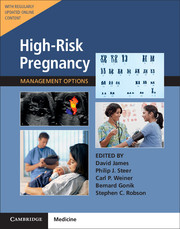Book contents
- Frontmatter
- Contents
- List of Contributors
- Preface
- Section 1 Prepregnancy Problems
- Section 2 Early Prenatal Problems
- Section 3 Late Prenatal – Fetal Problems
- Section 4 Problems Associated with Infection
- 23 Intrauterine Infection, Preterm Parturition, and the Fetal Inflammatory Response Syndrome
- 24 Hepatitis Virus Infections in Pregnancy
- 25 Human Immunodeficiency Virus in Pregnancy
- 26 Rubella, Measles, Mumps, Varicella, and Parvovirus in Pregnancy
- 27 Cytomegalovirus, Herpes Simplex Virus, Adenovirus, Coxsackievirus, and Human Papillomavirus in Pregnancy
- 28 Parasitic Infections in Pregnancy
- 29 Other Infectious Conditions in Pregnancy
- Section 5 Late Pregnancy – Maternal Problems
- Section 6 Late Prenatal – Obstetric Problems
- Section 7 Postnatal Problems
- Section 8 Normal Values
- Index
23 - Intrauterine Infection, Preterm Parturition, and the Fetal Inflammatory Response Syndrome
from Section 4 - Problems Associated with Infection
- Frontmatter
- Contents
- List of Contributors
- Preface
- Section 1 Prepregnancy Problems
- Section 2 Early Prenatal Problems
- Section 3 Late Prenatal – Fetal Problems
- Section 4 Problems Associated with Infection
- 23 Intrauterine Infection, Preterm Parturition, and the Fetal Inflammatory Response Syndrome
- 24 Hepatitis Virus Infections in Pregnancy
- 25 Human Immunodeficiency Virus in Pregnancy
- 26 Rubella, Measles, Mumps, Varicella, and Parvovirus in Pregnancy
- 27 Cytomegalovirus, Herpes Simplex Virus, Adenovirus, Coxsackievirus, and Human Papillomavirus in Pregnancy
- 28 Parasitic Infections in Pregnancy
- 29 Other Infectious Conditions in Pregnancy
- Section 5 Late Pregnancy – Maternal Problems
- Section 6 Late Prenatal – Obstetric Problems
- Section 7 Postnatal Problems
- Section 8 Normal Values
- Index
Summary
Introduction
Inflammation is a frequent and important cause of spontaneous preterm birth. Indeed, it is the only pathologic process for which both a causal link with spontaneous preterm birth has been established and a molecular pathophysiology defined. Fetal infection/ inflammation has been implicated in the genesis of fetal and neonatal injury leading to cerebral palsy (CP) and chronic lung disease. Perhaps the most important insight over the past two decades has been the recognition that microorganisms are but one cause of inflammation, and that chronic fetal hypoxemia too can produce a pattern of brain inflammation similar to that seen in cerebral palsy.
Pathways of Intrauterine Infection
Microorganisms may gain access to the amniotic cavity and the fetus through the following pathways:
• ascend from the vagina and the cervix
• hematogenous dissemination through the placenta
• retrograde seeding from the peritoneal cavity through the fallopian tubes
• accidental introduction at the time of invasive procedures.
The most common pathway for intrauterine infection is believed to be the ascending route (see later for further discussion). Supporting evidence includes:
• Histologic chorioamnionitis is more common and severe at the site of membrane rupture.
• In virtually all cases of congenital pneumonia (stillbirths or neonatal), inflammation of the chorioamniotic membranes is present.
• Bacteria identified in cases of congenital infections are similar to those found in the lower genital tract.
• In twin gestations, histologic chorioamnionitis is more common in the first-born twin and has not been demonstrated only in the second twin. This suggests ascending infection, because the membranes of the first twin are typically apposed to the cervix. This observation is consistent with microbiologic studies of the amniotic fluid (AF) in twin gestations. When AF infection is present, the presenting sac is always involved.
Stages of Ascending Intrauterine Infection
Ascending intrauterine infection has four stages (Figure 23.1):
• Stage I: This consists of a change in the vaginal/ cervicalmicrobial flora or the presence of pathologic organisms in the cervix. Some forms of aerobic vaginitis may be an early manifestation of this stage.
• Stage II: Once microorganisms traverse the endocervical canal, they reside in the lower pole of the amniotic cavity. A localized inflammatory reaction causes local chorioamnionitis.
• Stage III: The microorganisms may then traverse intact membranes and invade the amniotic cavity002E
- Type
- Chapter
- Information
- High-Risk Pregnancy: Management OptionsFive-Year Institutional Subscription with Online Updates, pp. 579 - 603Publisher: Cambridge University PressFirst published in: 2017



